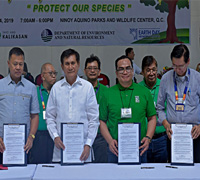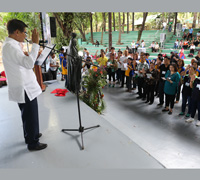DENR, CFC unite to plant 1 million trees

The Department of Environment and Natural Resources (DENR) is partnering with the Philippine-based Catholic movement Couples for Christ (CFC) on an initiative to plant one million trees under the government’s Expanded National Greening Program (ENGP).
Tapping different non-government organizations from various sectors like the CFC is “vital” to achieving the goals of ENGP, according to DENR Secretary Roy A. Cimatu.
“We are glad that an organization such as the CFC, a church-based organization, is helping us in our goal to protect the environment by taking part in the ENGP,” Cimatu said.
The DENR-CFC partnership was formalized through a memorandum of agreement signed by Cimatu and CFC-Philippines president Michael Ariola. DENR Undersecretary for Policy, Planning and International Affairs Jonas Leones and CFC social development programs head Mon De Leon also signed the agreement as witnesses.
CFC is a global lay organization intended for strengthening the Christian family life. The organization started in the country in 1981, and was approved by the Catholic Bishops Conference of the Philippines as a national private association of lay faithful in 1996.
Under the MOA, the CFC has committed to contribute to the national reforestation effort by planting one million forest tree seedlings from 2019 to 2021, and maintaining and protecting the planted seedlings during that period.
The DENR, on the other hand, is tasked to give technical assistance to CFC in terms of identifying the forestlands where the seedlings will be planted, conduct survey, planning and mapping, and identify the suitable tree species that should be planted in the areas concerned.
Each party would provide a focal person for the coordination of the activities and for talking with the representatives of the people’s organization who would take care of the planted trees in specified areas.
The ENGP is the continuation of the previous National Greening Program, and was signed under the Executive Order 193 in 2015. It covers all the remaining unproductive, denuded and degraded forestlands which will span from 2016 to 2028.
The government’s flagship reforestation program aims to “pursue sustainable development for poverty alleviation, food security, climate change mitigation and adaptation, and biodiversity conservation.”
- Details
- Parent Category: News & Events
- Category: Press Releases



